Tektronix MDO3 series of oscilloscopes up to 1 GHz with spectrum analyzer
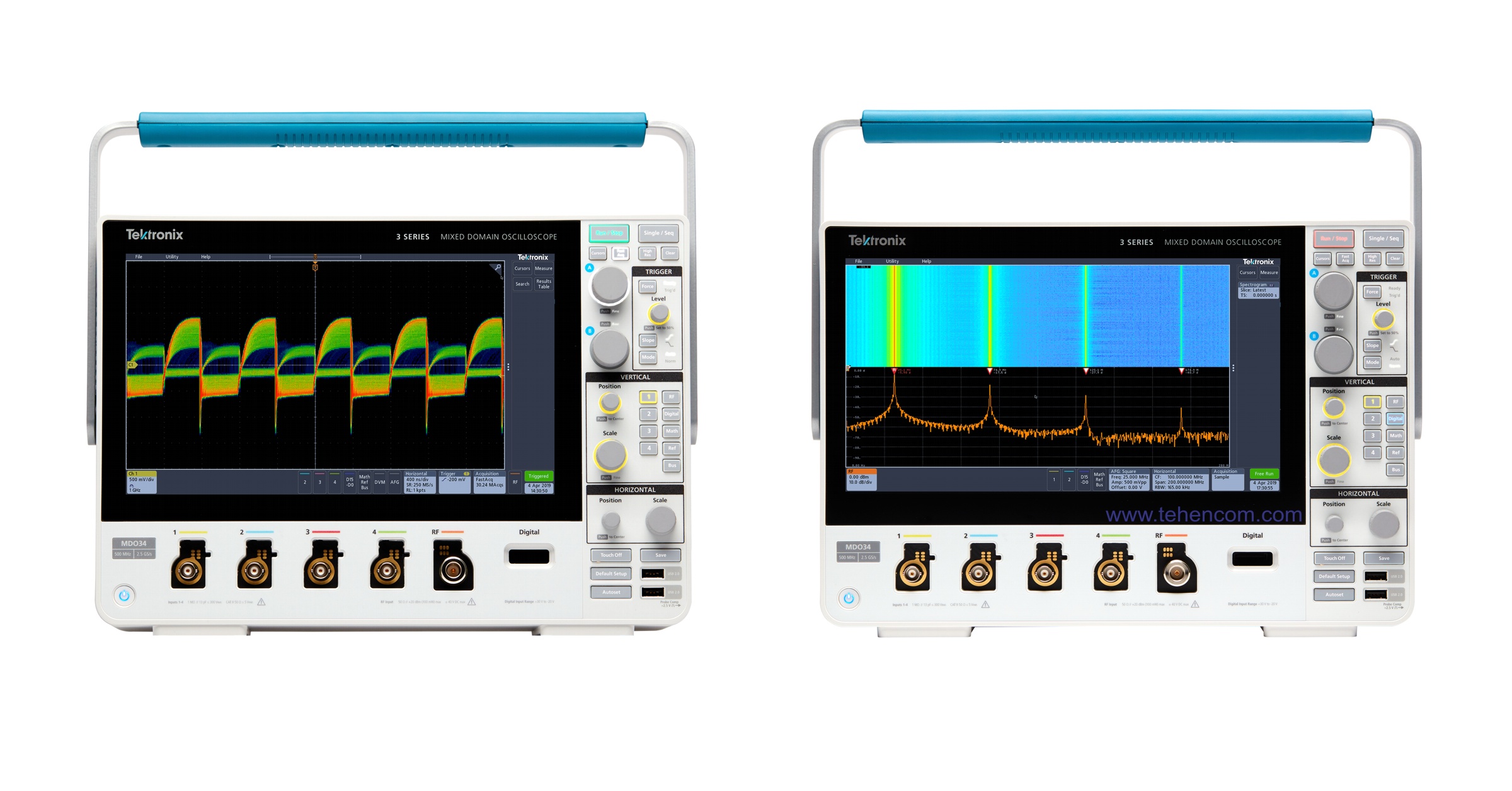
Brief description of the series
Oscilloscopes (six in one) of the Tektronix MDO3 series are ideal for designing and debugging complex electronic systems containing analog and digital signals, as well as radio-frequency components. The Tektronix MDO3 series is based on the previous successful Tektronix MDO3000 series and repeats most of its characteristics, but unlike the MDO3000, the new MDO3 series is equipped with a large touch screen with a resolution of 1920 × 1080 pixels and an innovative user interface that completely repeats the interface of the senior oscilloscope series (MSO4, MSO5 and MSO6).
The Tektronix MDO3 oscilloscope combines six instruments into one: a professional digital oscilloscope, built-in spectrum analyzer, arbitrary waveform and function generator, 16-channel logic analyzer, serial protocol analyzer, and digital voltmeter/frequency counter. The MDO3 series oscilloscope can be upgraded over time, including bandwidth expansion, by activating software options. For detailed differences between the models in the series, see the interactive table. A full description of all characteristics can be downloaded below on this page in the Documentation section.
All models of the series
The Tektronix MDO3 series consists of ten models, shown in this interactive table. To see all the characteristics of certain models, add them to the comparison.
| Model |
Bandwidth
|
Analog channels
|
Digital channels
|
Sample rate
|
Spectrum analysis
|
Weight
|
|---|---|---|---|---|---|---|
| 100 MHz | 2 | 16 | 2.5 GS/s | 9 kHz – 1 GHz 9 kHz – 3 GHz | 5.26 kg | |
| 100 MHz | 4 | 16 | 2.5 GS/s | 9 kHz – 1 GHz 9 kHz – 3 GHz | 5.31 kg | |
| 200 MHz | 2 | 16 | 2.5 GS/s | 9 kHz – 1 GHz 9 kHz – 3 GHz | 5.26 kg | |
|
Top sales
|
200 MHz | 4 | 16 | 2.5 GS/s | 9 kHz – 1 GHz 9 kHz – 3 GHz | 5.31 kg |
| 350 MHz | 2 | 16 | 2.5 GS/s | 9 kHz – 1 GHz 9 kHz – 3 GHz | 5.26 kg | |
| 350 MHz | 4 | 16 | 2.5 GS/s | 9 kHz – 1 GHz 9 kHz – 3 GHz | 5.31 kg | |
| 500 MHz | 2 | 16 | 2.5 GS/s | 9 kHz – 1 GHz 9 kHz – 3 GHz | 5.26 kg | |
| 500 MHz | 4 | 16 | 2.5 GS/s | 9 kHz – 1 GHz 9 kHz – 3 GHz | 5.31 kg | |
|
Expert's choice
|
1 GHz | 2 | 16 | 5 GS/s | 9 kHz – 1 GHz 9 kHz – 3 GHz | 5.26 kg |
| 1 GHz | 4 | 16 | 5 GS/s | 9 kHz – 1 GHz 9 kHz – 3 GHz | 5.31 kg |
Main features of the series
100 MHz, 2.5 GS/s, 2 channels (model Tektronix MDO32-BW-100).
100 MHz, 2.5 GS/s, 4 channels (model Tektronix MDO34-BW-100).
200 MHz, 2.5 GS/s, 2 channels (model Tektronix MDO32-BW-200).
200 MHz, 2.5 GS/s, 4 channels (model Tektronix MDO34-BW-200).
350 MHz, 2.5 GS/s, 2 channels (model Tektronix MDO32-BW-350).
350 MHz, 2.5 GS/s, 4 channels (model Tektronix MDO34-BW-350).
500 MHz, 2.5 GS/s, 2 channels (model Tektronix MDO32-BW-500).
500 MHz, 2.5 GS/s, 4 channels (model Tektronix MDO34-BW-500).
1 GHz, 5 GS/s, 2 channels (model Tektronix MDO32-BW-1000).
1 GHz, 5 GS/s, 4 channels (model Tektronix MDO34-BW-1000).
Record length: 10 million points per channel.
Vertical resolution: 8 bits (11 bits in high resolution mode).
Sensitivity: 1 mV/div to 10 V/div with calibrated fine tuning.
Continuous waveform capture rate: up to 280 000 waveforms/s.
Built-in spectrum analyzer 9 kHz – 1 GHz (up to 3 GHz with option 3-SA3).
Built-in digital voltmeter and frequency counter (included as standard).
Additional options: built-in generator of standard and arbitrary signals, built-in logic analyzer for 16 digital channels, protocol analyzer: I2C, SPI, RS-232/422/485/UART, USB 2.0, CAN, LIN, FlexRay, MILSTD-1553, audio buses and others.
29.5 cm touchscreen (1920 × 1080 resolution). Interfaces: USB, Ethernet, HDMI, etc.
Weight: 5.26 kg or 5.31 kg. Dimensions: 370 × 252 × 149 mm. Operating temperature: from -10°С to +55°С.
Since the main task of an oscilloscope is to visualize electrical signals, having a large screen with the highest possible resolution becomes a serious advantage compared to simpler models. This is especially true when working with multiple analog and digital signals at the same time, as well as the results of automatic measurements. For comparison, this photo shows the screen of the MDO3 series oscilloscope with a resolution of 1920 × 1080 pixels, on which two areas typical for the screen resolutions of other models are highlighted: 800 × 480 and 1280 × 800. The difference is obvious.
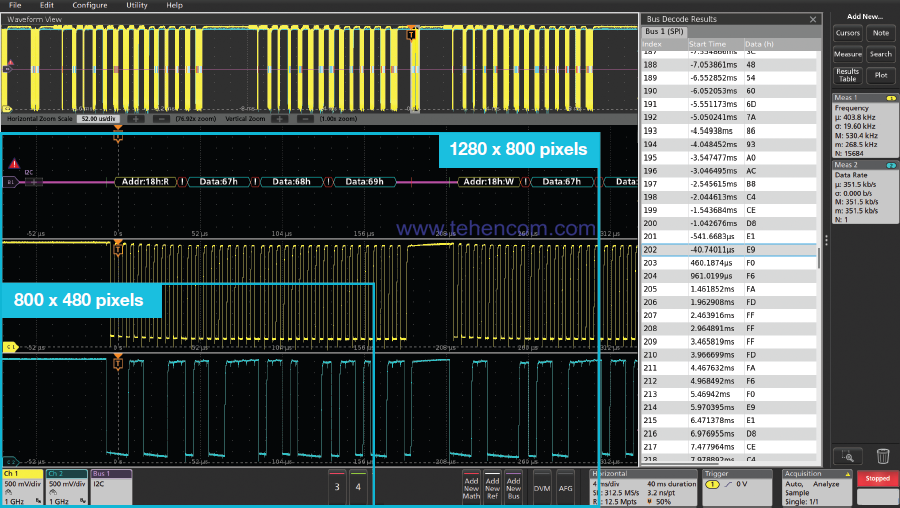
The Tektronix MDO3 series oscilloscopes contain six instruments that engineers most often need: a professional digital oscilloscope, spectrum analyzer, signal generator, 16-channel logic analyzer, serial protocol analyzer, and digital voltmeter/frequency counter. By integrating all these capabilities into a single instrument, the Tektronix MDO3 oscilloscopes provide excellent value for money.
Need more RF spectrum analysis capabilities? See the Tektronix MDO4000C series.
Necessary up to 6 FlexChannel with a band up to 1.5 GHz? See the Tektronix MSO4 series.
Necessary up to 8 FlexChannel at a band up to 2 GHz? See the Tektronix MSO5 series.
Need an inexpensive USB oscilloscope up to 200 MHz? See the PicoScope 3000D series.
Need a professional oscilloscope up to 8 GHz? See the Tektronix MSO6 series.
Need an oscilloscope over 8 GHz bandwidth? See the Tektronix DPO/MSO70000 series.
Difficult to decide on a model? See the assistant: How to quickly choose an oscilloscope.
All series of modern oscilloscopes are presented here: Digital oscilloscopes.
Tektronix MDO3 and MSO4 series video review
A few years ago, the American company Tektronix released two new series of oscilloscopes equipped with large touch screens, a new user interface and many innovative functions. The appearance of these two series was preceded by painstaking work and hundreds of consultations with leading development engineers so that the capabilities of the new oscilloscopes included all their wishes. As a result, the MDO3 (up to 1 GHz) and MSO4 (up to 1.5 GHz) series were developed. This dynamic video trailer shows the strongest points of these two series.
Professional digital oscilloscope
The MDO3 series oscilloscopes are high-end instruments with a variety of features to speed up every stage of debugging: from quickly detecting and capturing anomalies to searching through the waveform record for events of interest, analyzing the characteristics of the events and the behavior of the device under test. The oscilloscopes of this series contain many innovative features, one of which is the DPO digital phosphor technology, which greatly simplifies the search for various anomalies of electrical signals.
To effectively detect signal anomalies, the Tektronix MDO3 oscilloscopes measure up to 280 000 waveforms per second. The oscilloscope's dedicated processor analyzes thousands of waveforms in real time and highlights rare events with color gradations. This feature of the MDO3 series oscilloscopes allows you to reliably detect single signal deviations, even those as short as 3.5 µs. The photo below shows an example of this feature in action. Always present signals are displayed in shades of red and yellow, and rare ones in dark blue.
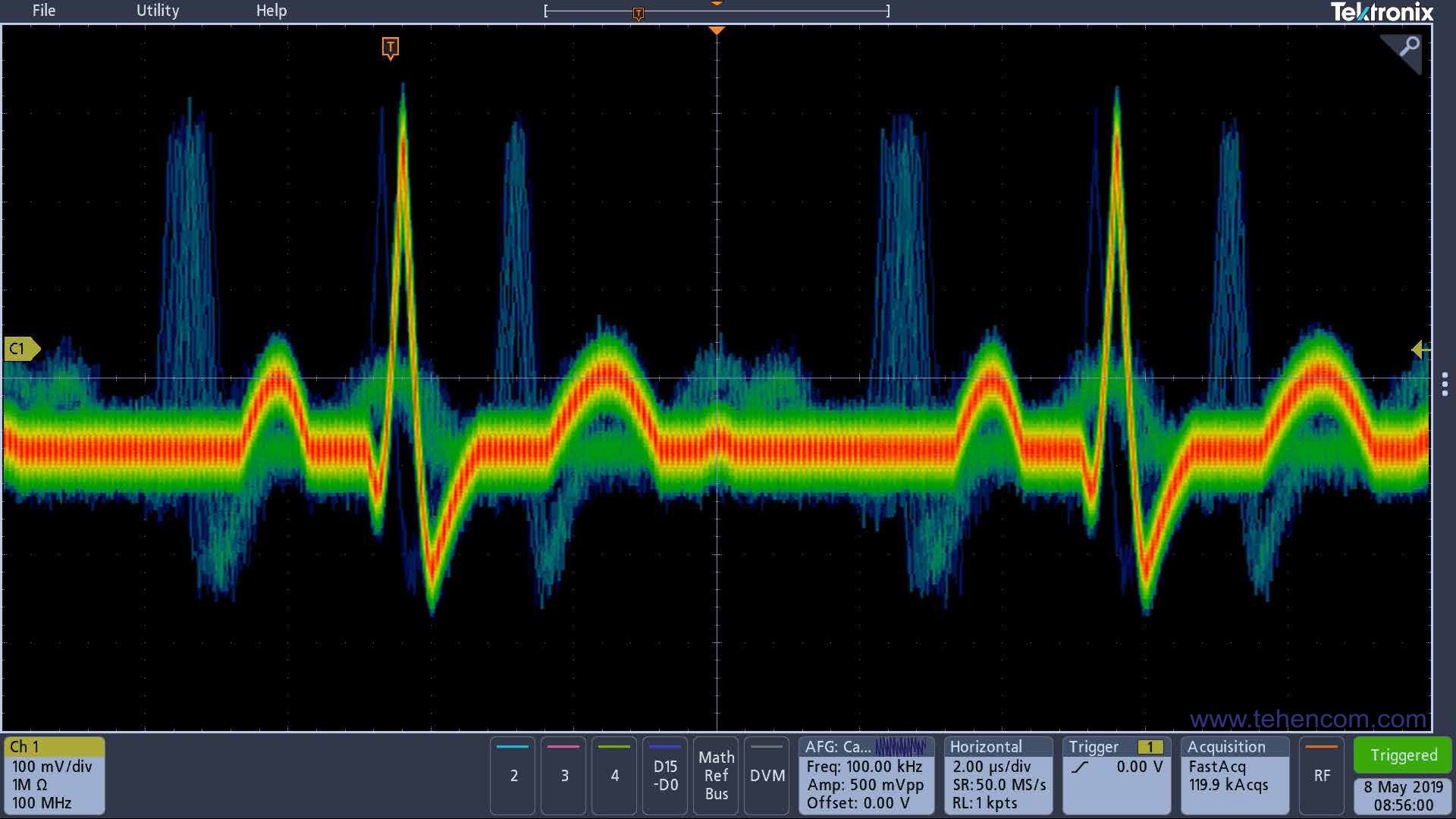
Finding a device fault is just the first step. Now you need to capture the event of interest to find its cause. The MDO3 series oscilloscope has over 125 trigger combinations, giving you a full range of options to help you find the event of interest faster. You can trigger on runt, logical combination, pulse/glitch width, setup and hold violations, serial packets and parallel bus data. And with record lengths up to 10 million points per channel, you can capture multiple events of interest, or even thousands of serial packets, while maintaining high resolution to see every detail of the signal. The trigger options menu is shown on the right side of this screenshot.
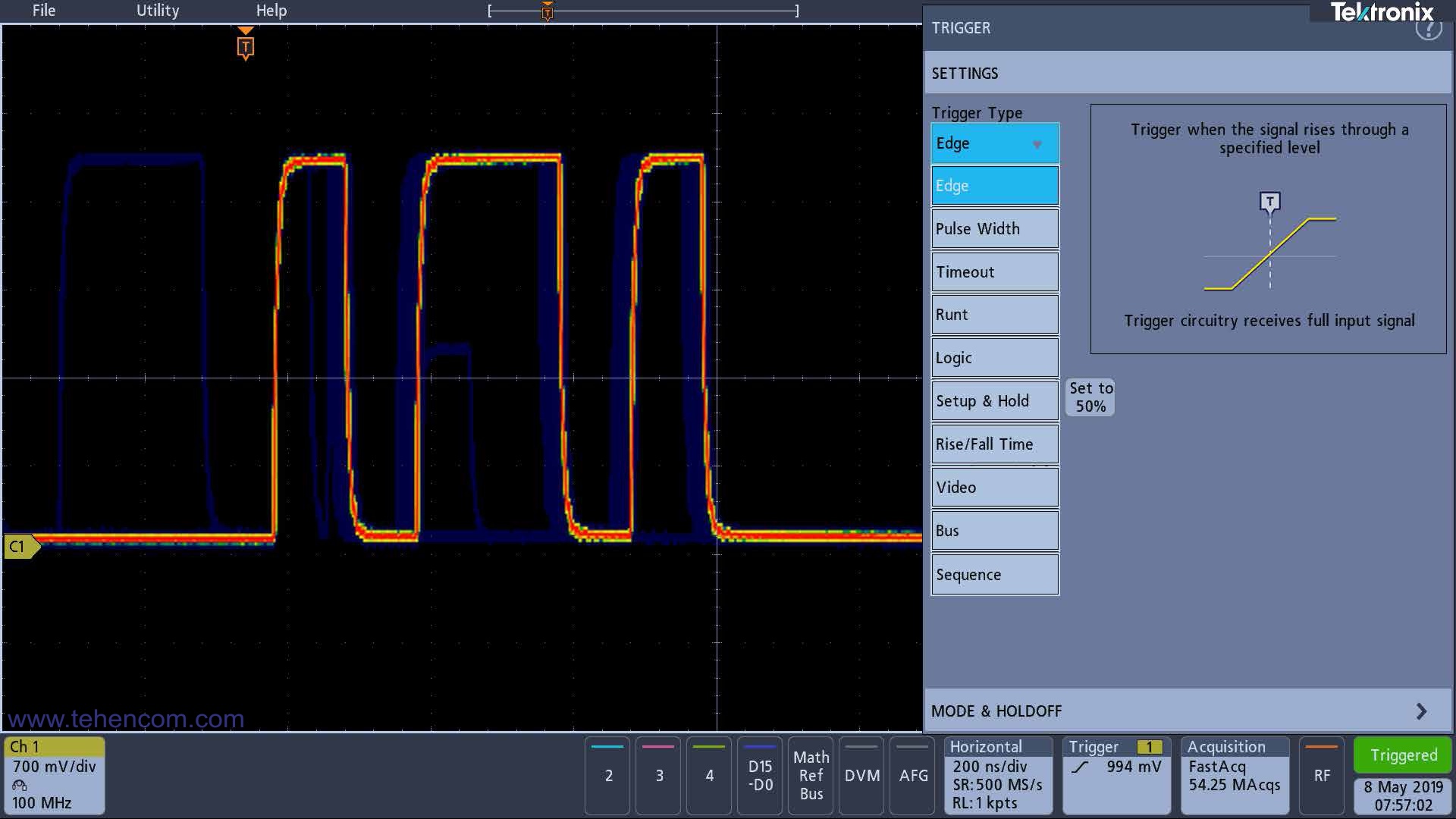
In order to check the compliance of the technical characteristics of the device under study with the required standards and to make sure that it is capable of solving the tasks set, it is necessary to analyze all operating modes of this device. This work may require a wide variety of measurements: from a simple check of the rise time and pulse duration to a complex analysis of power losses on individual components, an assessment of the quality of clock signals and an investigation of noise sources.
The Tektronix MDO3 series oscilloscopes offer a wide range of built-in analysis tools, including cursors linked to the signal or screen, automated measurements, an extended set of math functions, including an equation editor, fast Fourier transform (FFT), statistics, and more. As an example, this screenshot shows a square wave signal, the parameters of which are determined by the automatic measurements function. For each activated measurement, a separate rectangular badge is displayed on the right side of the oscilloscope screen, containing updated results.
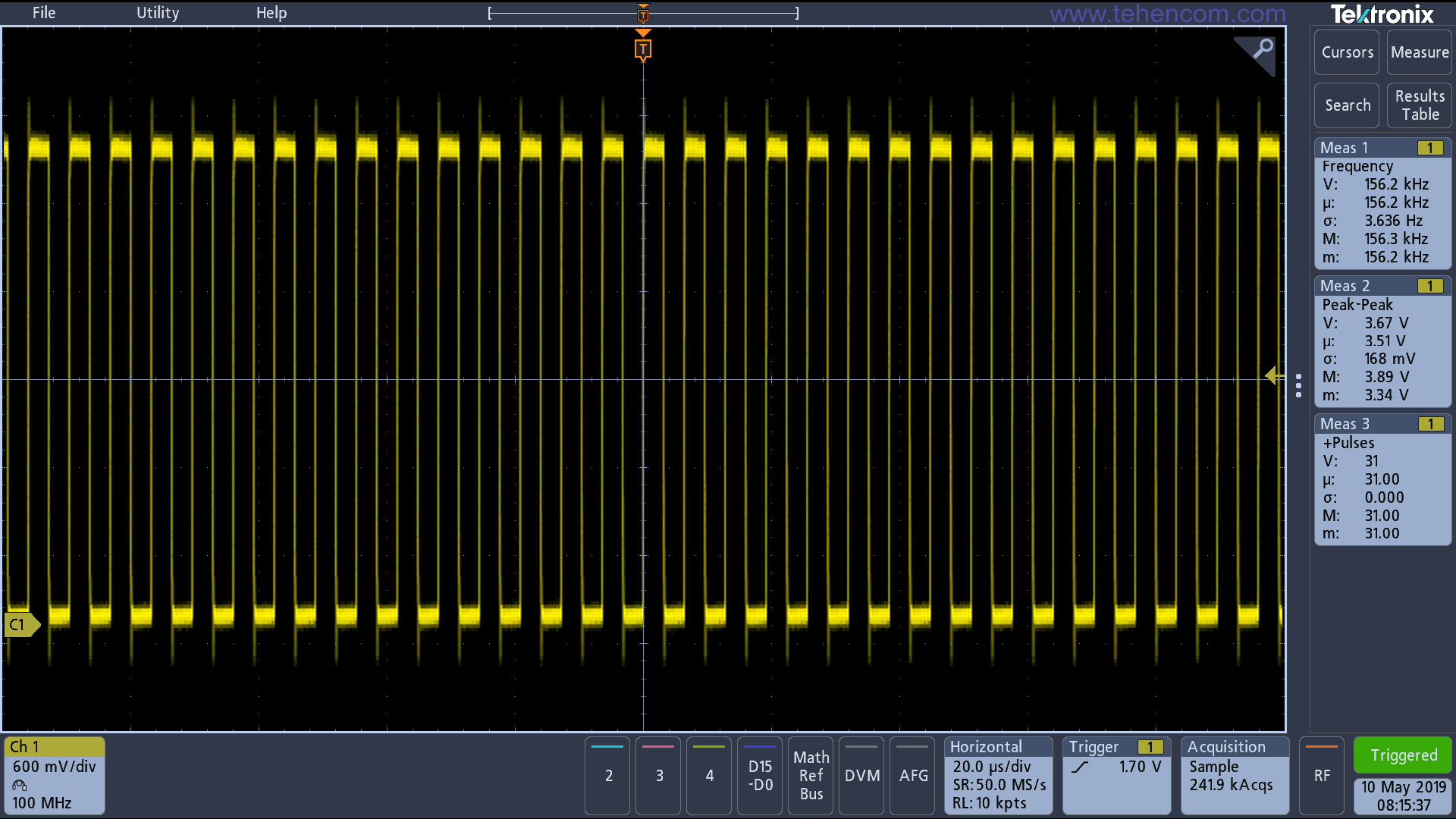
The large recording length of modern oscilloscopes allows one capture to obtain thousands of screens of information. On the one hand, this is good, since it allows analyzing large volumes of data, but on the other hand, the analysis itself turns into a labor-intensive process, since it is very difficult to manually find the event of interest among thousands and millions of similar events. But the Tektronix MDO3 series oscilloscopes feature industry-leading navigation and automatic search capabilities that help you find events of interest in seconds. Event types that can be automatically searched for include: signal edge and fall time, rise time and fall time, pulse width, timeout, runt, setup time and hold time, logic pattern, specific serial or parallel bus data, and more.
As an example, the entire channel 1 signal sample, containing 10 million samples, is shown at the top of this screenshot from a Tektronix MDO3. It looks like a long yellow rectangle with no visible signal details. The oscilloscope automatically searched for signal runts (pulses that have a lower level than all other pulses) across this entire sample and found three such events. All three found events are marked with small white triangles located above the top selection. In the center of the screen is a greatly enlarged fragment of the selection containing the second of the three found runs. It is possible to easily move from one found event to another by simply pressing the "left" and "right" arrows, and also to change the scale using the knobs on the front panel, or simply using the touch screen.
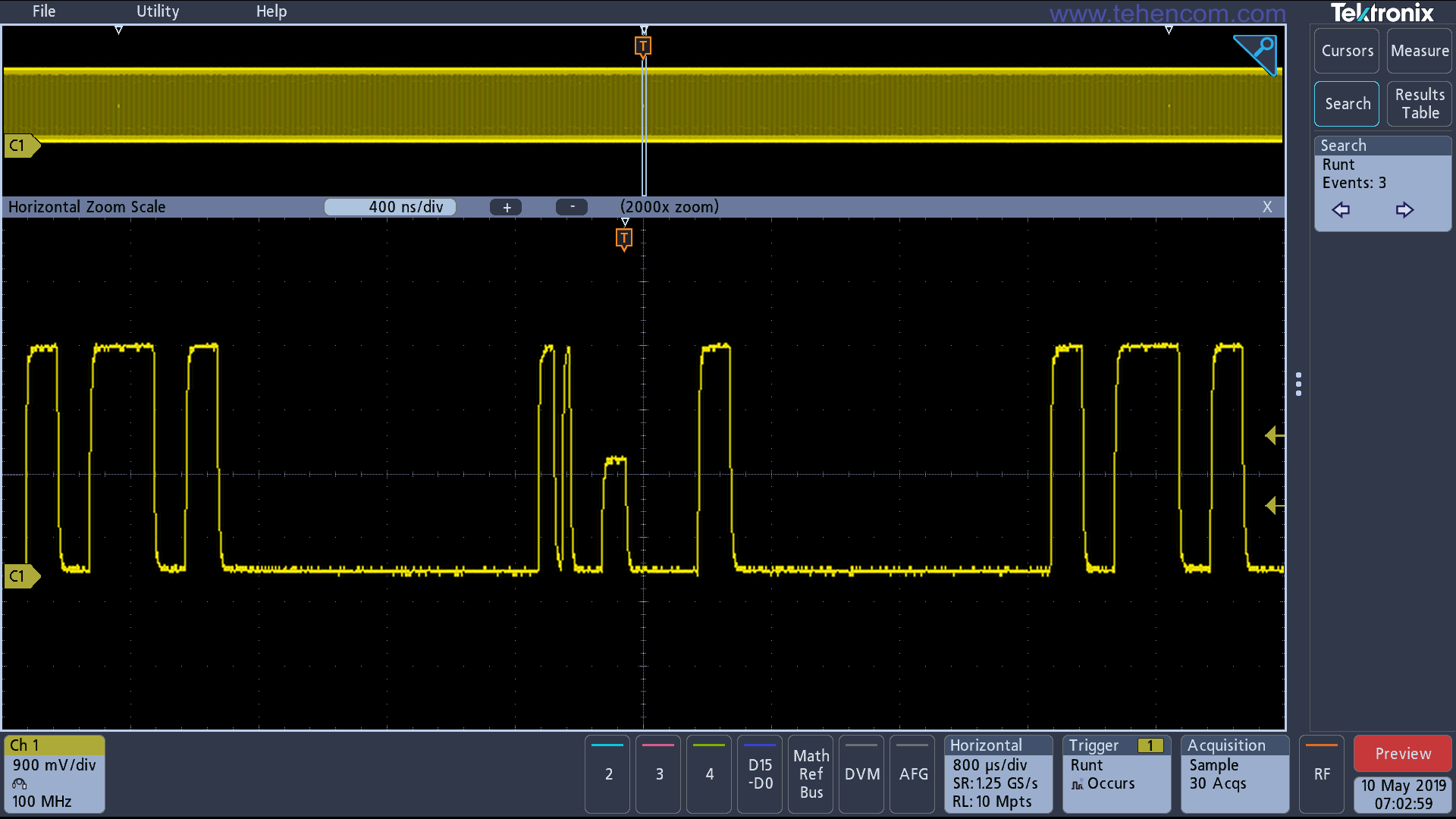
All Tektronix professional oscilloscopes of the MDO3, MSO4, MSO5 and MSO6 series are equipped with touch screens with a resolution of 1920 by 1080 pixels and a uniform, well-thought-out user interface, which significantly speeds up and simplifies the work process. The uniformity of the interface and logic of interaction with the oscilloscopes of the specified series allows you to preserve the developed techniques when moving from simpler series (MDO3 and MSO4) to the most functional (MSO5 and MSO6).
An important feature of the MDO3 series oscilloscopes is that the bandwidth can be increased after purchasing the device, if necessary. The bandwidth can be increased to 200, 350 or 500 MHz directly by the owner of the device, by purchasing a software key. To increase the bandwidth to 1 GHz, you must contact the Tektronix service center.
Spectrum analyzer
All Tektronix MDO3 series oscilloscopes include a full hardware spectrum analyzer with a separate RF input equipped with a standard 50 ohm N(f) connector for RF measurements. The spectrum analyzer with a frequency range of 9 kHz to 1 GHz is present in all MDO3 series instruments. The frequency range of 9 kHz to 3 GHz is available as Option 3-SA3, which can be activated either when ordering the instrument or during its operation.
Since many modern devices contain a radio path, it is necessary to carry out measurements not only in the time domain, but also in the frequency domain. At the same time, traditional solutions based on FFT are of little use, since they have very low sensitivity. And the full-featured spectrum analyzer of the Tektronix MDO3 oscilloscope significantly expands the area of useful application of this device. The appearance of the radio frequency connector of the built-in spectrum analyzer is shown in this photo.
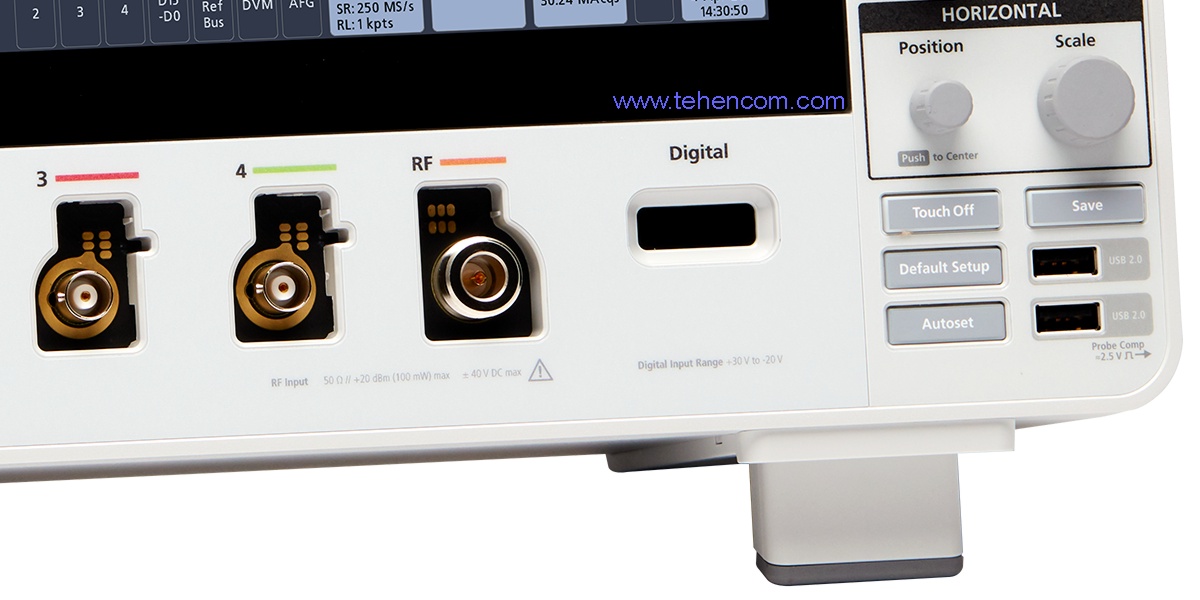
When using the spectrum analyzer's RF input, the MDO3 Series oscilloscope's display switches to a full-screen frequency domain display. All key spectrum parameters, such as Center Frequency, Span, Reference Level, and RBW, are easily and quickly adjusted using the touchscreen menu or familiar knobs and buttons on the front panel.
Three types of automated RF measurements are possible: Channel Power, Occupied Bandwidth, and Adjacent Channel Power Ratio. When any of these measurement modes are activated, the MDO3 automatically switches to the Average detection method.
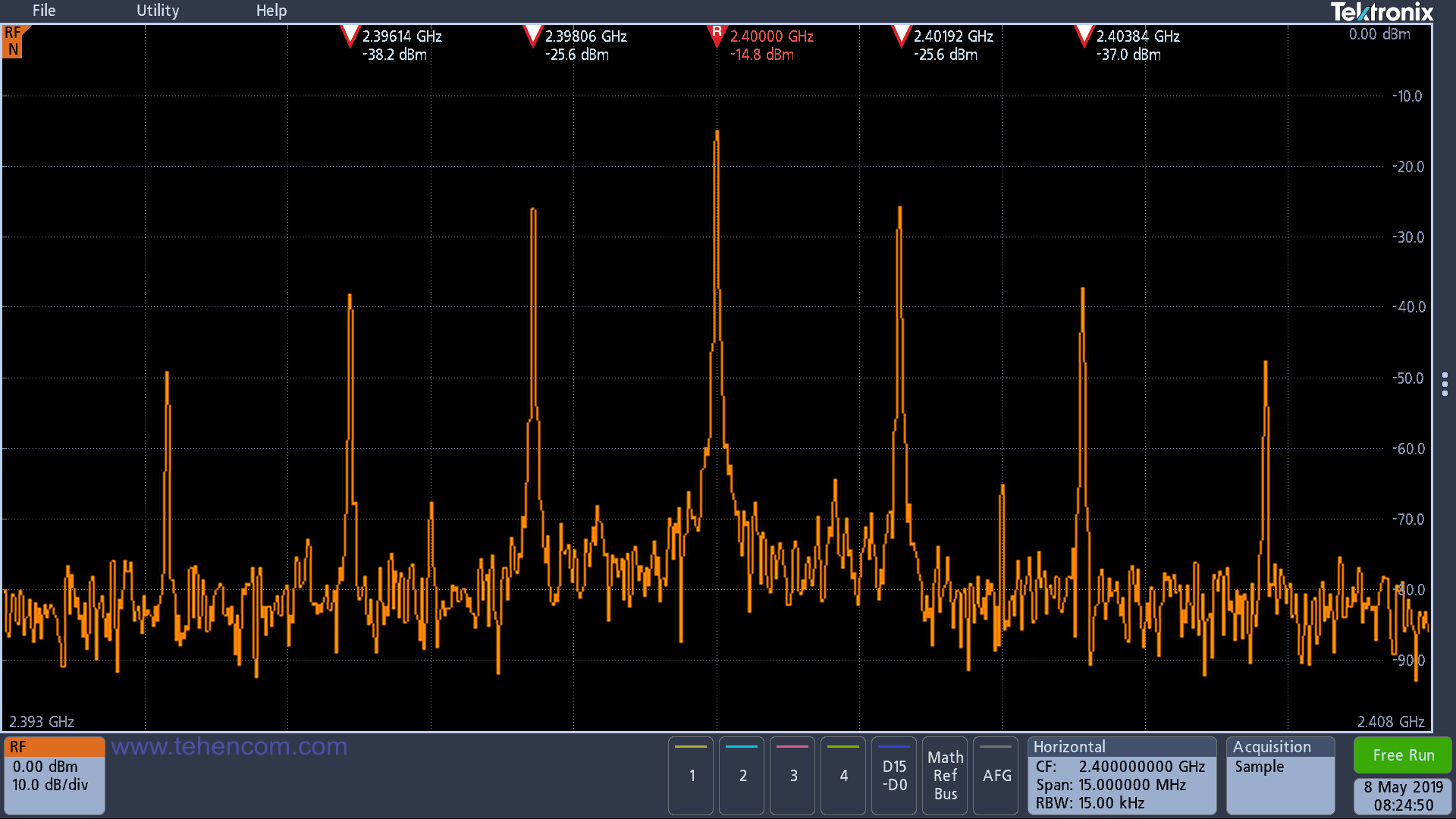
In addition to the standard spectrum analysis features, the MDO3 series oscilloscopes can display multiple spectra in a cumulative spectrogram, which is ideal for tracking slowly changing events in RF signals. When the instrument is in this mode, the X-axis contains frequency values (as in a normal spectrum graph), the Y-axis corresponds to the time at which a particular spectrum was measured, and the amplitude level is indicated by different colors. Cool colors (shades of blue and green) represent low amplitudes, and hot colors (shades of red and yellow) represent high amplitude signals.
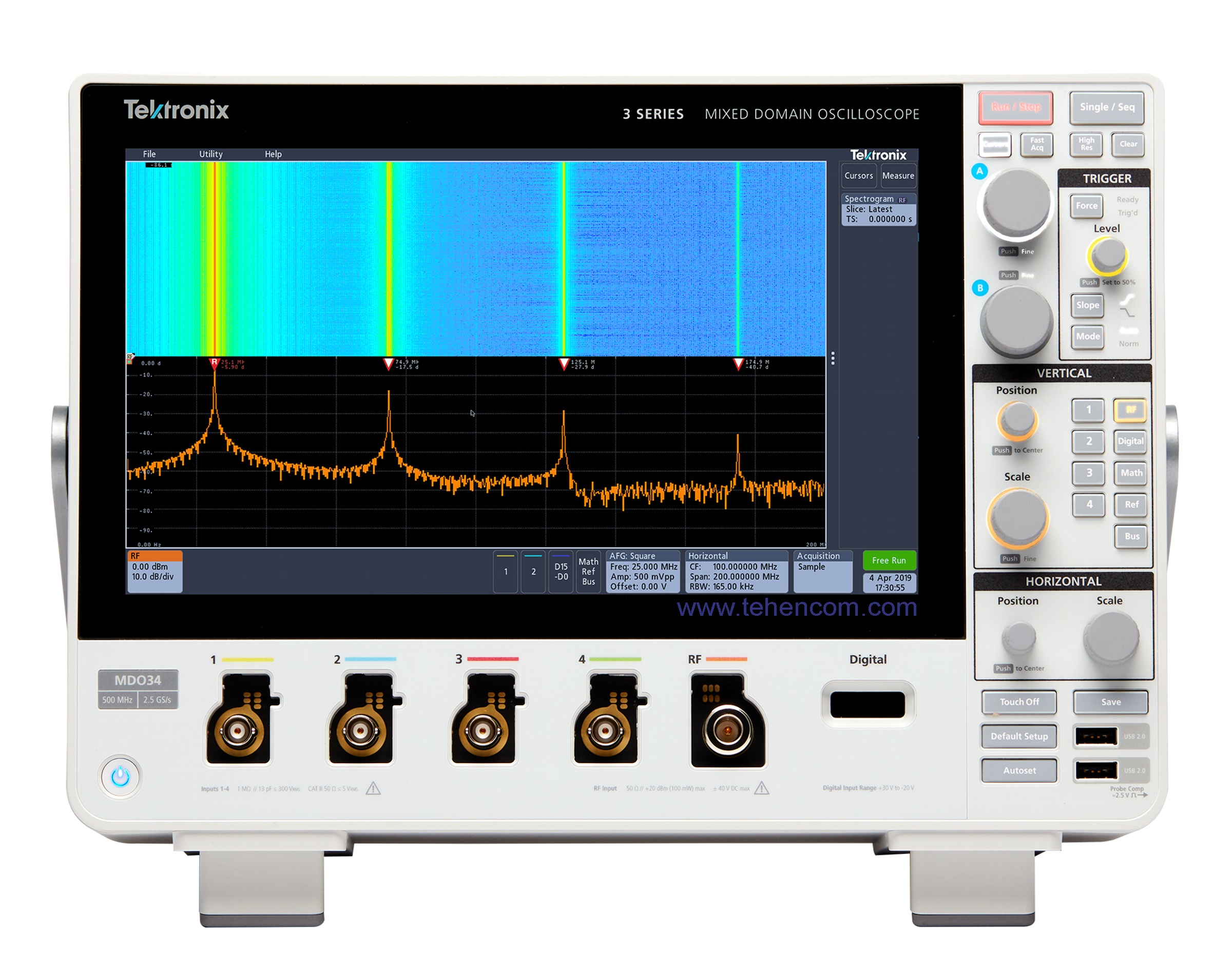
Signal generator
The MDO3 series oscilloscopes include an optional built-in arbitrary function generator (option 3-AFG) that is ideal for simulating a variety of signals while debugging any device. Noise can be added to the signals generated by the generator to simulate harsh operating conditions.
The built-in generator of arbitrary waveforms and standard functions produces various waveforms: sinusoidal (with a frequency of up to 50 MHz), rectangular, sawtooth and pulse, constant voltage, noise, signals of the functions of the cardinal sine (Sinc), Gaussian and Lorentz, exponential rise and fall, haversine, cardiac signal, etc. In addition to a variety of standard signals, the built-in Tektronix MDO3 oscilloscope generator can generate any arbitrary signals pre-loaded into the device's internal memory.
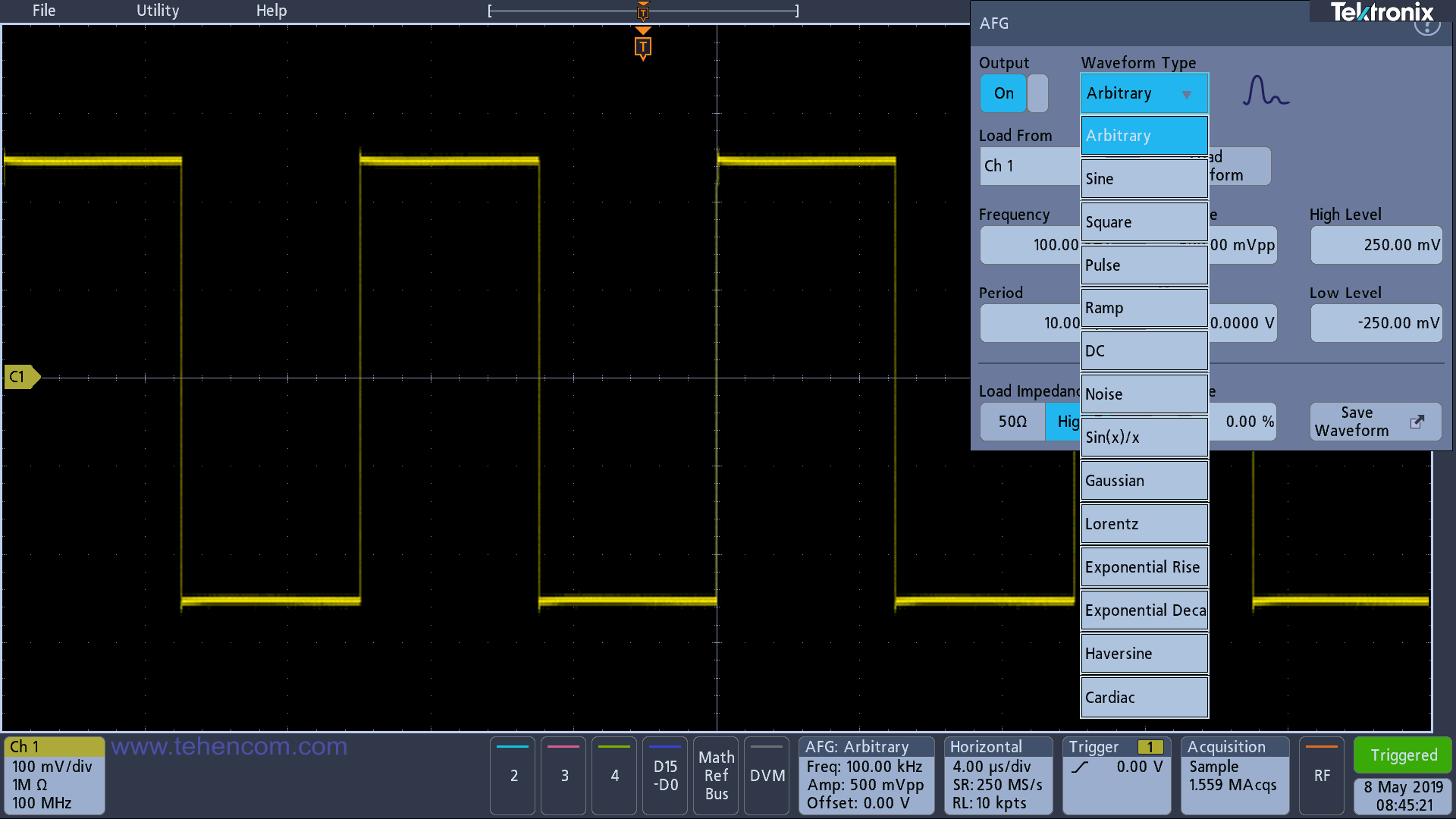
Logic analyzer
The Tektronix MDO3 oscilloscope's 3-MSO option adds a 16-channel digital logic analyzer that is fully integrated into the oscilloscope's user interface. This simplifies operation and makes it easier to solve problems when analyzing signals in various areas. The logic analyzer is connected to digital buses using the P6316 16-channel digital probe, which is included in the 3-MSO option. An example of the logic analyzer in operation is shown in this screenshot, which shows the input 8-bit parallel bus of the DAC and its analog output (the first channel of the oscilloscope – yellow sine).
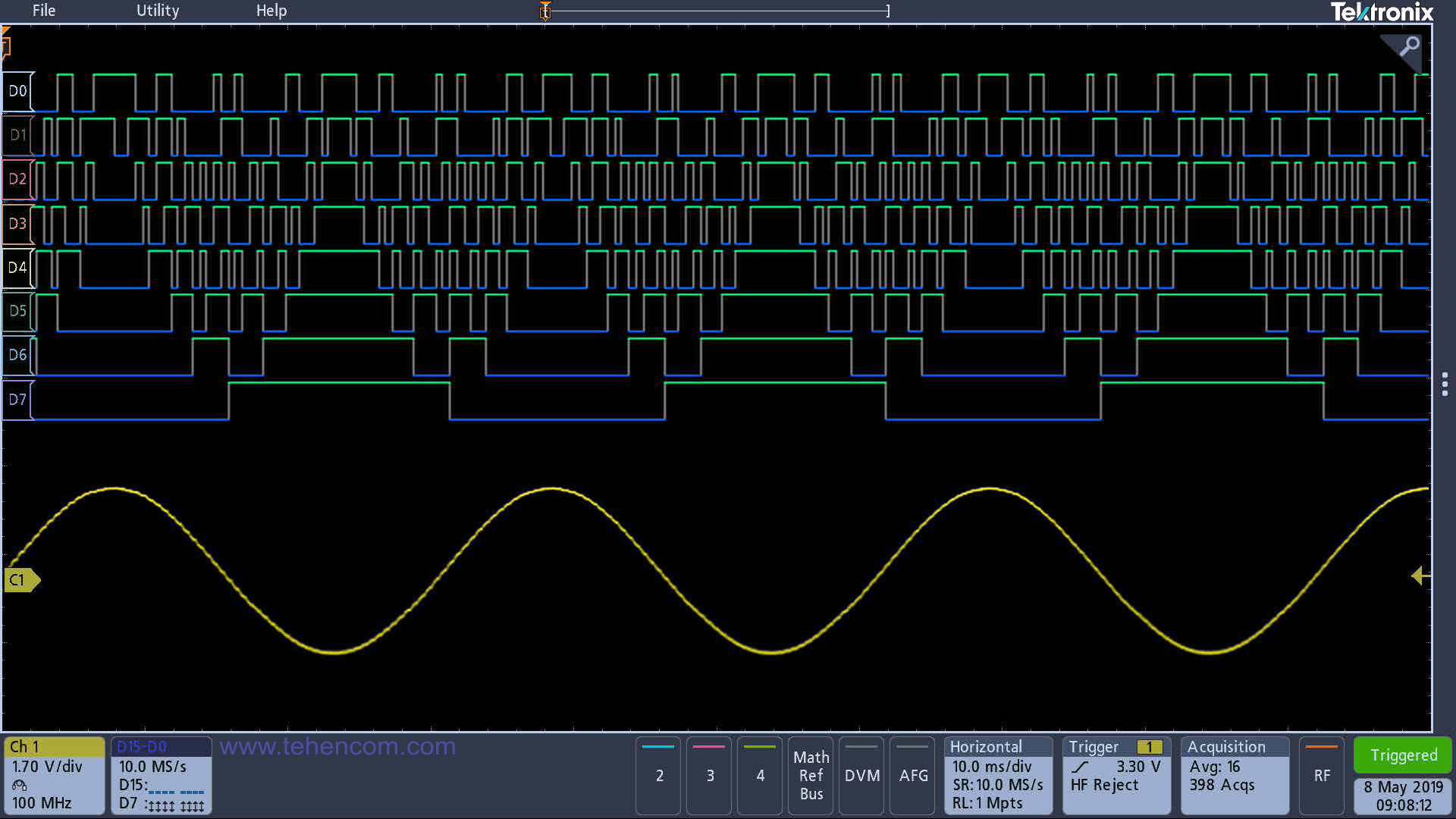
Serial protocol analyzer
Serial bus signals typically contain address, control information, data, and clock frequency, making it difficult for an engineer to interpret the image on the oscilloscope screen and manually isolate events of interest. On the other hand, automatic triggering, decoding, and searching for events and conditions in signals transmitted over a serial bus allow for full automation of routine work and create a robust set of serial bus debugging tools.
With the appropriate options, the Tektronix MDO3 series oscilloscopes can automatically capture, decode, and analyze the following serial protocols:
- option 3-SRAERO (MIL-STD-1553 and ARINC 429)
- option 3-SRAUDIO (I2S, LJ, RJ, and TDM)
- option 3-SRAUTO (CAN, CAN FD, LIN, and FlexRay)
- option 3-SRCOMP (RS-232, RS-422, RS-485, and UART)
- option 3-SREMBD (I2C and SPI)
- option 3-SRUSB2 (USB2.0 LS, FS, and HS)
To enable all these capabilities at once, a single 3-BND option is offered, which is sold at a significant discount and includes the following options: 3-SRAERO, 3-SRAUDIO, 3-SRAUTO, 3-SRCOMP, 3-SREMBD, 3-SRUSB2, as well as the 3-PWR option (measurement and analysis of the characteristics of power electronic components).
As an example, this screenshot shows the Tektronix MDO3 oscilloscope screen in I2C serial bus address trigger mode. The yellow trace represents the bus clock, and the blue trace represents the data being transmitted on the bus. Below them is the decoded contents of the bus packets, including Start, Address, Read/Write, Data, and Stop.
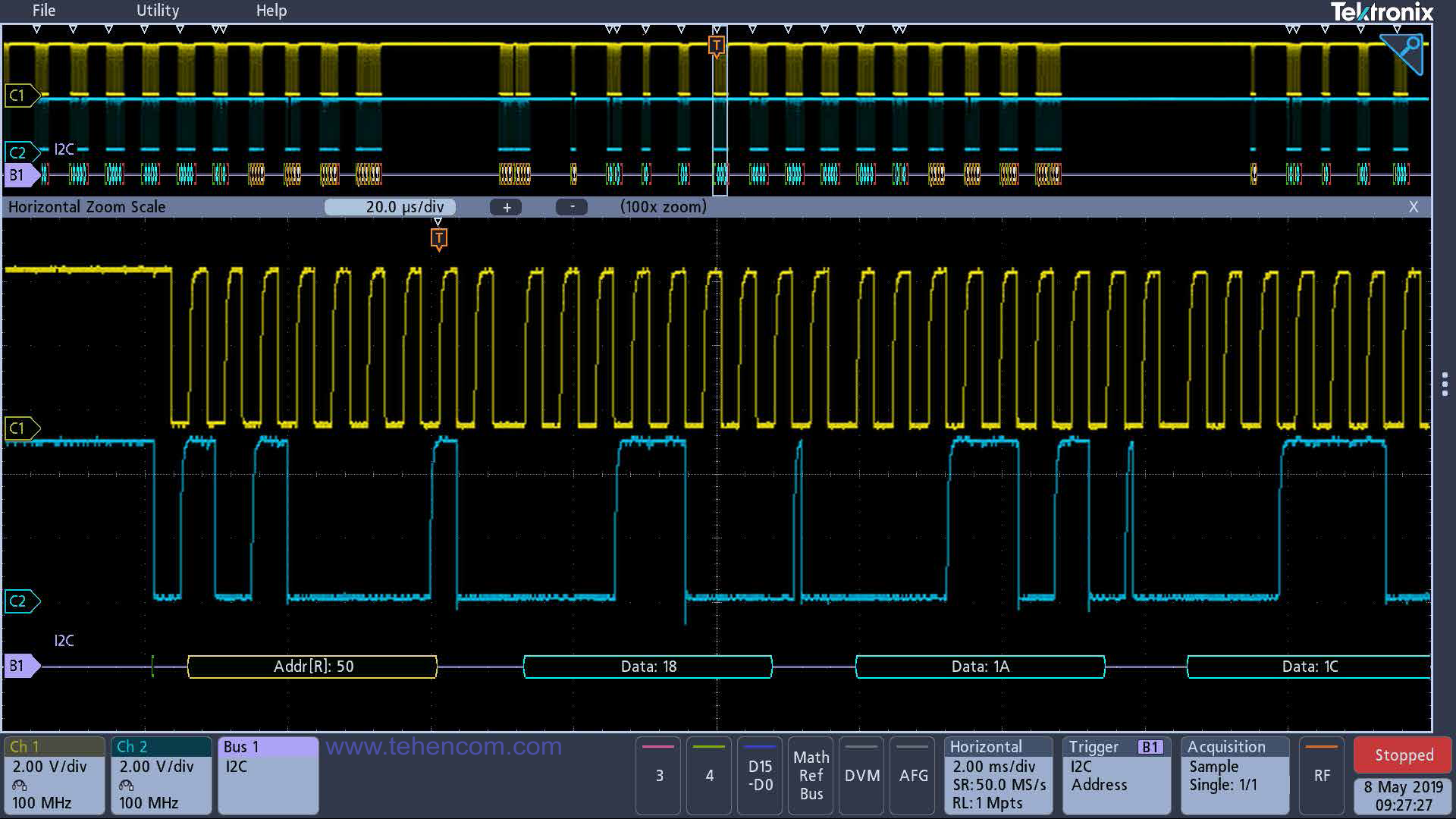
Voltmeter and frequency counter
The MDO3 oscilloscopes contain a built-in 4-digit digital voltmeter and 5-digit frequency counter. The signal from any analog input of the oscilloscope can be fed to the voltmeter or frequency counter without switching probes. The measurement results are dynamically updated on the device display in digital or graphical form. Depending on the selected multimeter mode, the results can include: instantaneous, average, maximum and minimum values. The digital voltmeter and frequency meter are available in all MDO3 series models and are activated when registering the device.
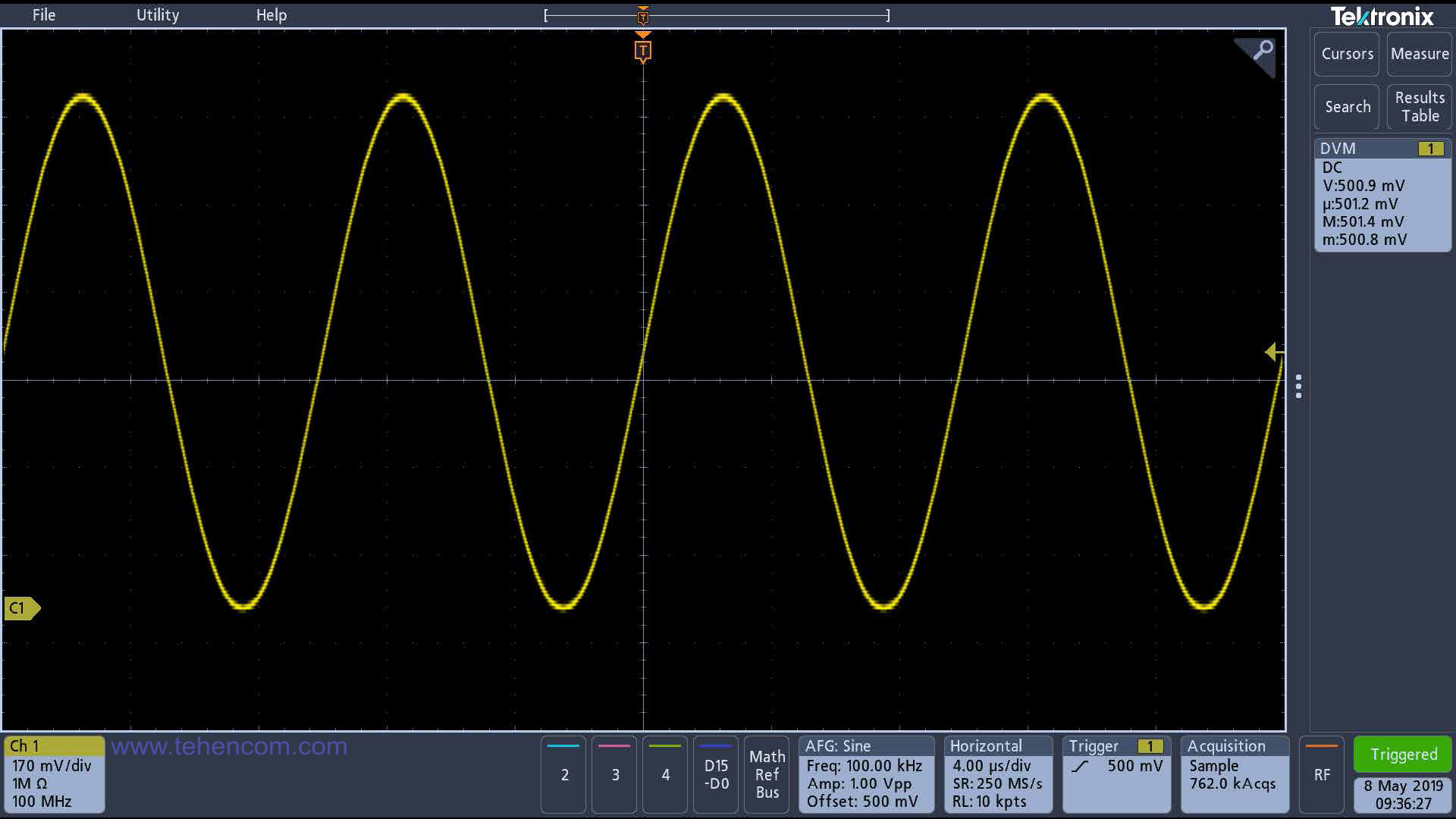
High-quality probes
Oscilloscope probes are as important as the oscilloscope itself. Since the probe is located between the measurement object and the oscilloscope, the quality of the measurements performed largely depends on it. An ideal probe should have a good bandwidth, low input capacitance, a sufficient level of permissible voltage, be convenient and reliable.
The standard Tektronix MDO3 oscilloscope probes have all of these features. Their design has been refined over the years, and their electrical performance and reliability are among the best in the industry. Depending on the frequency range, Tektronix MDO3 oscilloscopes are equipped with different probes: one for each analog channel.
When ordering an oscilloscope with the 3-MSO option (16-channel logic analyzer), the package also includes a P6316 digital probe. The appearance of the P6316 probe is shown in the photo below. In general, many types of high-quality probes are produced for Tektronix MDO3 series oscilloscopes: passive, active, high-voltage, current, galvanically isolated, etc.
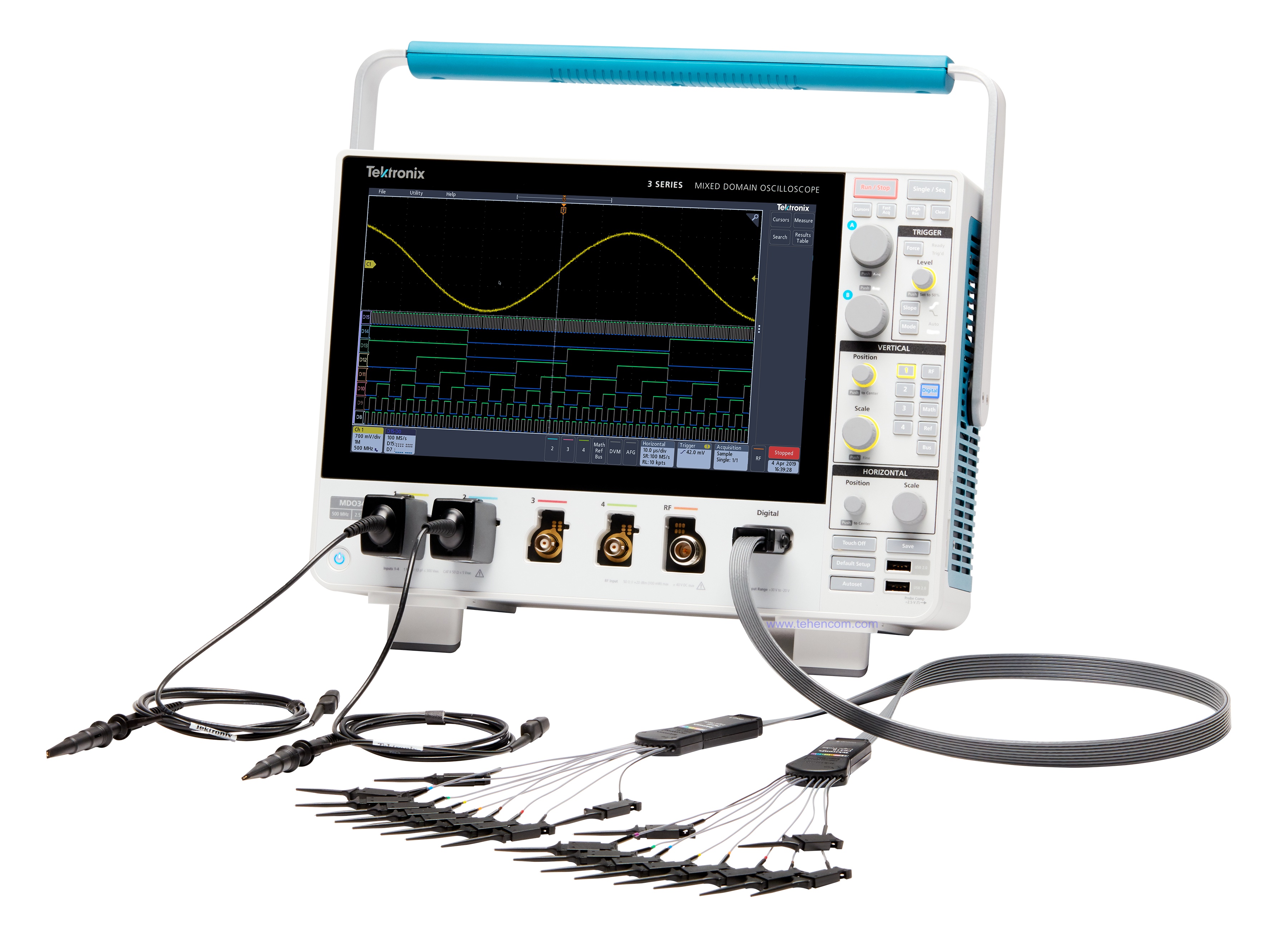
Communication interfaces
As standard, Tektronix MDO3 oscilloscopes are equipped with all interfaces required for remote control of these devices and for their inclusion in measuring systems. For automation of measurements, you can use the OpenChoice software, which is included in the delivery set.
This photo shows a fragment of the rear panel of the MDO3 oscilloscope, which contains the following communication interfaces: Ethernet with LXI support, USB 2.0 (for connecting to a computer), USB 2.0 (for connecting a flash drive), HDMI (for connecting an external display). To the left of the communication interfaces is the AFG Out function generator output (option 3-AFG).

Technical specifications
Below is a list of the key technical specifications of the Tektronix MDO3 series oscilloscopes. For detailed technical specifications, see the Documentation section further down this page.
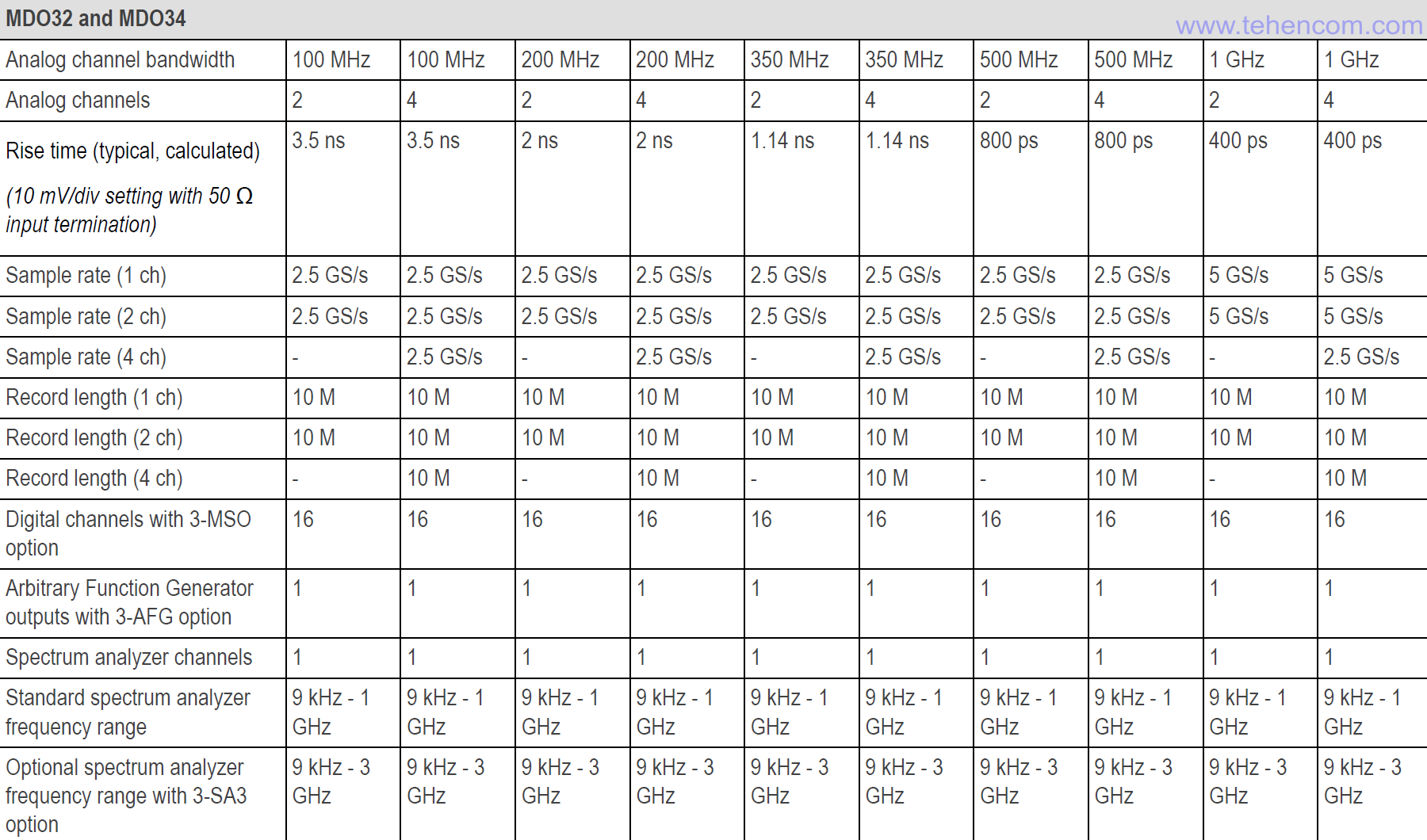
Options and accessories
Key options for Tektronix MDO3 series oscilloscopes:
- option 3-SA3 (expansion of the frequency range of the built-in spectrum analyzer to 3 GHz)
- option 3-MSO (logic analyzer for 16 digital channels complete with a P6316 digital probe)
- option 3-AFG (built-in generator of standard and arbitrary signals with a bandwidth of up to 50 MHz)
- option 3-SRAERO (MIL-STD-1553 and ARINC 429)
- option 3-SRAUDIO (I2S, LJ, RJ, and TDM)
- option 3-SRAUTO (CAN, CAN FD, LIN, and FlexRay)
- option 3-SRCOMP (RS-232, RS-422, RS-485, and UART)
- option 3-SREMBD (I2C and SPI)
- option 3-SRUSB2 (USB2.0 LS, FS, and HS)
- option RM3 (rack mount kit for the oscilloscope)
- option SC3 (soft transport bag with protective cover for the front panel of the oscilloscope)
- option HC3 (hard transport case for the oscilloscope and accessories)
The main probes and accessories compatible with the Tektronix MDO3 series of oscilloscopes are shown below. For detailed information on options, probes, and other accessories, see the Documentation section further down this page.
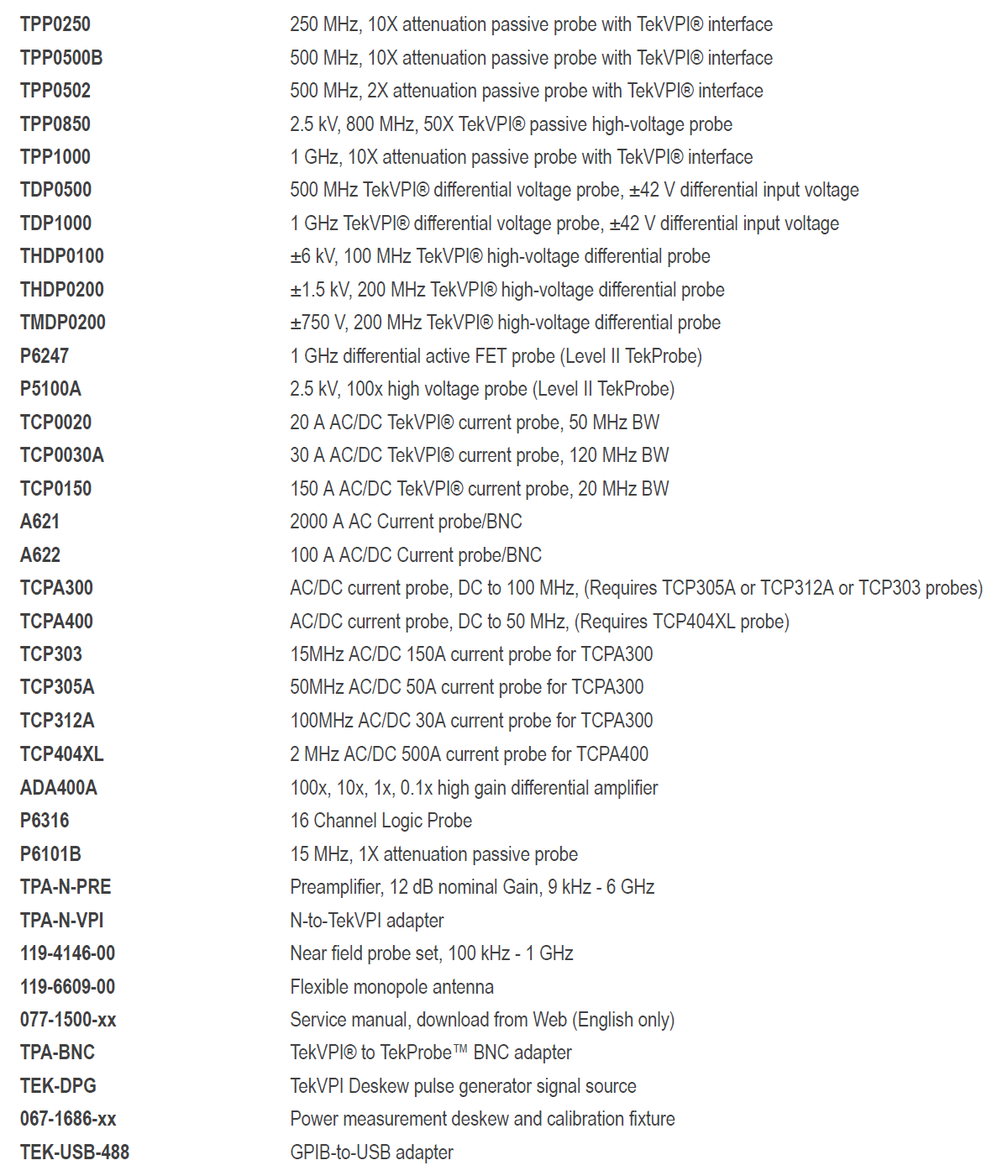
Documentation and useful materials
-
Description and characteristics of the Tektronix MDO3 series
EN, 36 pages, 3 MB
-
Description and characteristics of the Tektronix MDO3 series (in Russian)
RU, 40 pages, 2 MB
-
User manual of the Tektronix MDO3 series
EN, 297 pages, 6 MB
-
User manual of the Tektronix MDO3 series (in Russian)
RU, 400 pages, 6 MB
-
Quick start manual for Tektronix MDO3 series
EN, 39 pages, 2 MB
-
Quick start manual for Tektronix MDO3 series (in Russian)
RU, 58 pages, 2 MB